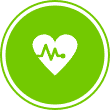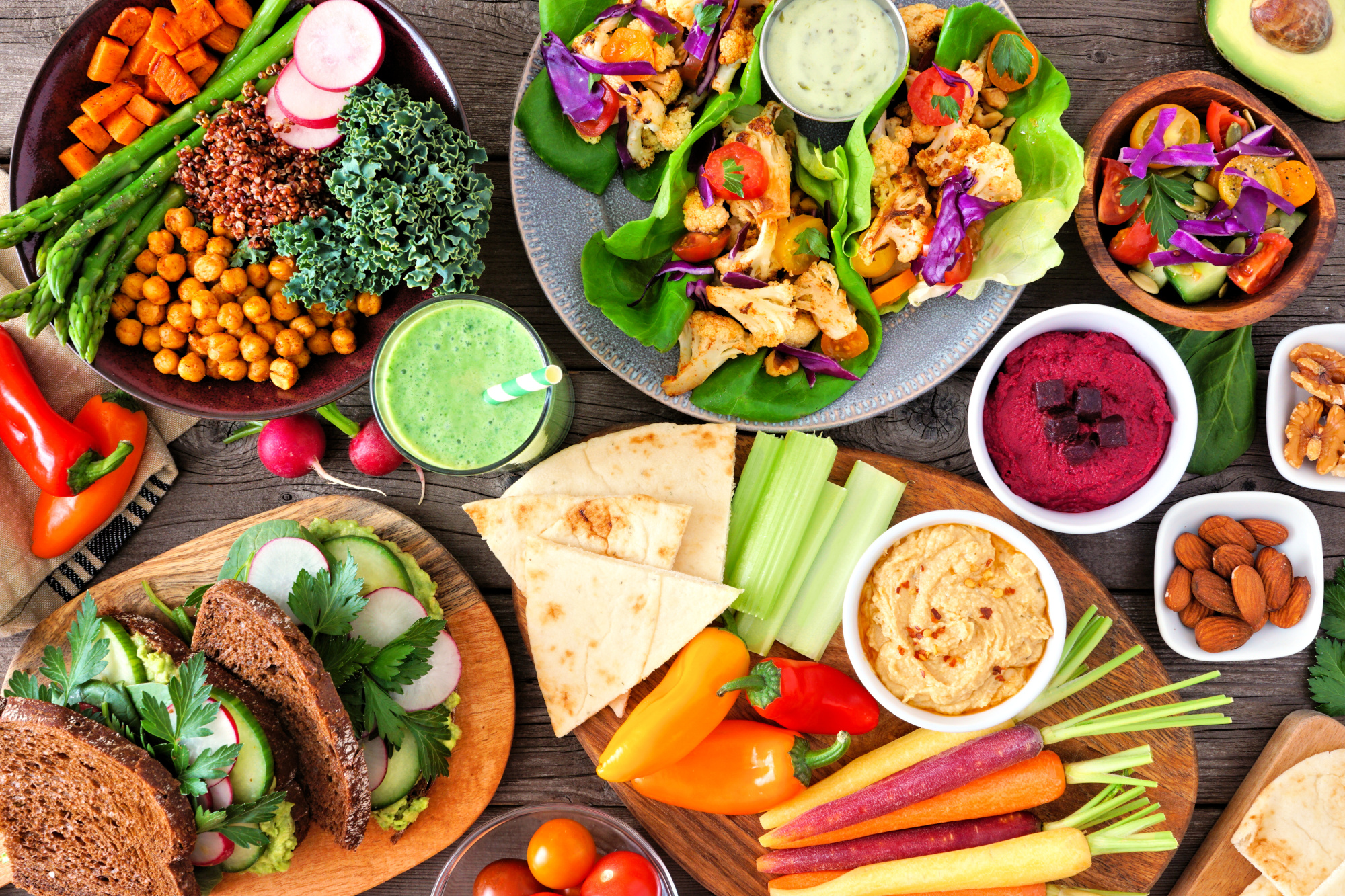Hypertension – more commonly known as high blood pressure – is one of the most common diseases in industrialised countries. 40% of people over the age of 25 are affected by the disease, which, in turn, is a major risk factor for cardiovascular and renal diseases. A plant-based diet is suitable for both the prevention and treatment of hypertension.
The cardiovascular system
The cardiovascular system is one of the most important organ systems in the human body. It allows blood to distribute all necessary nutrients, hormones, the oxygen we breathe, and many other chemical compounds from and to all cells and organs in the body. In this way, it also helps with regulating, stabilising, and maintaining body temperature and pH, as well as fighting diseases. The cardiovascular system consists of the blood, heart, and blood vessels. Blood pressure is one of the body’s key vital signs and describes the pressure of the circulating blood on the walls of the blood vessels. Normal blood pressure is considered to be less than 120/80 mmHg.1 2
Systolic and diastolic blood pressure
The muscle activity of the heart can be divided into two phases: in the systolic phase, blood is pumped from the heart chambers into the body’s and the lungs’ circulatory system; in the diastolic phase, the heart chambers fill with blood again. Both phases of muscle activity can be mapped using a blood pressure monitor. The first reading indicates the maximum pressure the heart exerts when it beats (systolic). Diastolic blood pressure refers to the pressure in the arteries between heartbeats.3
What is hypertension?
Hypertension is a cardiovascular disease. High blood pressure is defined as systolic blood pressure above 130 mmHg or diastolic blood pressure above 80 mmHg (see table 1). Blood pressure is commonly measured in millimetres of mercury (mmHg).4 Depending on the cause of the disease, a distinction is made between primary (essential) and secondary (symptomatic) hypertension. About 90% of all patients suffer from primary hypertension, which – unlike secondary hypertension – is not caused by another underlying disease.5 6
Classification of Hypertension
High blood pressure is divided into one of two categories, depending on the severity of the condition (see Table 1). It should be taken into account that systolic blood pressure increases with age. The reason for this is that the elastic walls of our blood vessels become more rigid as we grow older. If blood pressure values are elevated (that is, above 120/80 mmHg) there is a high risk of hypertension developing. Values above 130/80 mmHg, meaning systolic blood pressure higher than 130 and diastolic pressure of more than 80, are considered to be the markers of high blood pressure. A precise classification can be made using the following table.7 8
Table 1: Classification of blood pressure levels in adults9
Frequency of hypertension
Hypertension, also called ‘the silent killer’, often develops slowly and is sometimes asymptomatic. Worldwide, four out of 10 adults over the age of 25 are affected by arterial hypertension – high blood pressure in the arteries. According to the Global Burden of Disease (GBD) study, hypertension is the second most common risk factor for premature death worldwide. The World Hypertension League (WHL) estimates that approximately 10% of 2016’s global healthcare costs were due to high blood pressure and its complications.10 In low and middle-income countries, the treatment of people with high blood pressure could save 4.7 million lives over the course of a decade.11
Effects and symptoms of hypertension
Hypertension poses several health risks. It is estimated that the risk of dying from cardiovascular disease doubles with every 20 mmHg added to systolic blood pressure or every 10 mmHg increase in diastolic blood pressure.12 The increased pressure on the arteries can lead to them becoming damaged or constricted. This, in turn, can be a risk factor for arteriosclerosis.13 In addition, aneurysms (bulges in the arterial walls) may develop. In the worst-case scenario, an aneurysm will tear and cause internal bleeding. People suffering from high blood pressure are also at greater risk of vascular dementia, strokes, nerve damage to the eyes, and sexual dysfunction. Additionally, hypertension is also considered one of the most common causes of kidney failure, since high blood pressure can damage the kidneys’ small blood vessels, preventing waste products from being expelled.14 15
Causes of Hypertension
Diet and lifestyle have a major influence on the development of hypertension. In addition to genetic predisposition and pre-existing conditions such as diabetes mellitus type 2 and kidney disease, a high consumption of alcohol, tobacco, salt, and saturated fatty acids play a role as risk factors. On the other hand, regular exercise, a body weight in the ideal range, and an adequate supply of potassium can reduce blood pressure.16 A well-planned diet can therefore guard against the development of hypertension and be used to treat the condition.
Hypertension and animal products
Several studies have shown that there is a correlation between the consumption of red meat and high blood pressure.17 18 19 In addition to foods containing large amounts of saturated fatty acids, a high consumption of sodium, salt, or cholesterol also has a negative effect on blood pressure.20 Processed animal products, in particular, such as cheese, sausage, other meat products, and ready meals, are often very rich in salt, fat, and cholesterol.
Vegetarians and vegans are less likely to suffer from high blood pressure
According to several studies, people who follow vegetarian diets have lower blood pressure levels compared to people who eat meat.21 Some studies have shown that a high potassium intake, as found in a balanced, plant-based diet, lowers hypertension.22 Sources of potassium include fruit, vegetables, and pulses.23 Since potassium also has a physiologically antagonistic effect on sodium, increasing potassium intake in one’s diet can lower blood pressure.24 Magnesium and calcium also have a positive effect on high blood pressure.25 Both are found in green leafy vegetables, such as spinach, as well as in legumes, nuts, seeds, and whole grains.
According to a study published by Harvard Medical School in 2016, an increase in the intake of plant protein was associated with a lower mortality rate, especially cardiovascular mortality. “Substitution of plant protein for animal protein, especially from processed red meat, may confer a substantial health benefit. Therefore, public health recommendations should focus on improvement of protein sources”, the researchers concluded.26 A systematic review of 32 prospective cohort studies came to the same conclusion.27
The high consumption of animal-based products is one of the main causes of widespread lifestyle diseases such as obesity, diabetes, and cardiovascular disease. These diseases, as well as high blood pressure, can all be managed and even avoided by following a more plant-based diet that is less calorie dense and lower in saturated fats, salt, and refined sugars. Food from plants contains no dietary cholesterol and provides a plethora of vitamins, minerals, fibre, and secondary plant compounds, all of which play an important role in sustaining human health.
ProVeg tips for the prevention and therapy of hypertension
Hypertension can be treated and counteracted with a healthy diet and lifestyle:
- Eat a diet rich in fruit and vegetables, particularly those containing high levels of potassium and magnesium.
- Try to choose plant-based protein.
- Reduce the intake of saturated fatty acids and cholesterol. Instead, aim for a higher amount of monounsaturated and polyunsaturated fatty acids.
- Switch to a plant-based diet.
- Reduce salt consumption.
- Avoid cigarettes and alcohol as far as possible.
- Maintain a healthy weight.
- Engage in sufficient physical activity.
Should blood pressure reach stage 1 and it is not possible to reduce it to the desired extent with a change in diet and lifestyle, medication should be administered by a doctor.
Pro Health
These are general nutrition guidelines. If you have concerns about your diet, please talk to your doctor about seeing a dietitian. Discussing the use of supplements with a health professional will help to ensure that they are suitable for you. Never stop taking prescribed medications without first talking to your doctor.
References
- Institute for Quality and Efficiency in Health Care (IQWiG) (2019): How does the blood circulatory system work? Available at: https://www.ncbi.nlm.nih.gov/pubmedhealth/PMH0072434/ [22.12.2020]
- American Heart Association (2020): Understanding Blood Pressure Readings. Available at http://www.heart.org/HEARTORG/Conditions/HighBloodPressure/KnowYourNumbers/Understanding-Blood-Pressure-Readings_UCM_301764_Article.jsp#.WzuUCdIza70 [22.12.2020]
- Sheps, S. G. (2020): Pulse pressure: An indicator of heart health? Mayo Clinic. Available at https://www.mayoclinic.org/diseases-conditions/high-blood-pressure/expert-answers/pulse-pressure/faq-20058189 [22.12.2020]
- Lennon, S. L., DellaValle, D. M. et al. (2017): 2015 Evidence analysis library evidence-based nutrition practice guideline for the management of hypertension in adults. J Acad Nutr Diet. 117(9):1445–1458.e17. Available at http://www.ncbi.nlm.nih.gov/pubmed/28578899 [14.03.2018]
- Yaxley J. P., Thambar S. V. (2015): Resistant hypertension: an approach to management in primary care. Journal of family medicine and primary care, 4(2), 193–199. https://doi.org/10.4103/2249-4863.154630
- American Heart Association (2020): Understanding Blood Pressure Readings. Available at http://www.heart.org/HEARTORG/Conditions/HighBloodPressure/KnowYourNumbers/Understanding-Blood-Pressure-Readings_UCM_301764_Article.jsp#.WzuUCdIza70 [22.12.2020]
- Harris, I. & Lipkin, I. J. (1930): High blood pressure and cholesterin. Br Med J. 1(3612): 587–588. Available at https://www.ncbi.nlm.nih.gov/pmc/articles/PMC2313010/pdf/brmedj07485-0011.pdf [14.03.2018]
- National Heart, Lung, and Blood Institute (2004):The Seventh Report of the Joint National Committee on Prevention, Detection, Evaluation, and Treatment of High Blood Pressure. Available at https://www.ncbi.nlm.nih.gov/books/NBK9633/ [14.03.2018]
- American Heart Association (2020): Understanding Blood Pressure Readings. Available at: http://www.heart.org/HEARTORG/Conditions/HighBloodPressure/KnowYourNumbers/Understanding-Blood-Pressure-Readings_UCM_301764_Article.jsp#.WzuUCdIza70 [22.12.2020]
- Campbell, N. R., Khalsa, T. et al. (2016): High blood pressure 2016: why prevention and control are urgent and important. The World Hypertension League, International Society of Hypertension, World Stroke Organization, International Diabetes Foundation, International Council of Cardiovascular Prevention and Rehabilitation, International Society of Nephrology. J Clin Hypertens. 18(8):714–7. Available at https://onlinelibrary.wiley.com/doi/10.1111/jch.12840 [22.12.2020]
- Heller, D. J., Kishore, S. P. (2017): Closing the blood pressure gap: an affordable proposal to save lives worldwide. BMJ Glob Heal. BMJ Publishing Group; 2(3):e000429. Available at http://www.ncbi.nlm.nih.gov/pubmed/29018587 [22.12.2021]
- Coulston, A. M., Boushey, C. et al. (2017): Nutrition in the prevention and treatment of disease. 4th Edition. Academic Press; 1072 p. Available at http://www.sciencedirect.com/science/book/9780128029282 [14.03.2018]
- American Heart Association (2020): Atherosclerosis. Available at https://www.heart.org/en/health-topics/cholesterol/about-cholesterol/atherosclerosis [22.12.2020]
- Whelton, P. K., Carey, R. M. et al. (2017): 2017 ACC/AHA/AAPA/ABC/ACPM/AGS/APhA/ASH/ASPC/NMA/PCNA guideline for the prevention, detection, evaluation, and management of high blood pressure in adults. A report of the American College of Cardiology/American Heart Association Task Force on Clinical Pr. Hypertension.HYP.0000000000000066. Available at http://www.ncbi.nlm.nih.gov/pubmed/29133354 [22.12.2020]
- Mayo Clinic: High blood pressure dangers: Hypertension’s effects on your body. Available at https://www.mayoclinic.org/diseases-conditions/high-blood-pressure/in-depth/high-blood-pressure/art-20045868 [22.12.2020]
- National Health Service (NHS) (2019): Causes. High blood pressure (hypertension). Available at https://www.nhs.uk/conditions/high-blood-pressure-hypertension/causes/ [22.12.2020]
- Oude Griep L. M. et al. (2016). Relation of unprocessed, processed red meat and poultry consumption to blood pressure in East Asian and Western adults. Journal of hypertension, 34(9), 1721–1729. https://doi.org/10.1097/HJH.0000000000001008
- Austin J Pulm Respir Med (2015): Does Red Meat Metabolism Induce Hypertension? Available at http://austinpublishinggroup.com/pulmonary-respiratory-medicine/fulltext/ajprm-v2-id1019.php [14.03.2018]
- Diarz E.J. et al. (2020): Red meat consumption and its association with hypertension and hyperlipidaemia among adult Maasai pastoralists of Ngorongoro Conservation Area, Tanzania. Available at: https://doi.org/10.1371/journal.pone.0233777 [22.12.2020]
- World Health Organization (2015): Noncommunicable diseases: Hypertension. Available at: https://www.who.int/news-room/q-a-detail/noncommunicable-diseases-hypertension [22.12.2020]
- Yokoyama, Y., Nishimura, K., Barnard, N. D., Takegami, M., Watanabe, M. et al. (2014): Vegetarian diets and blood pressure: a meta-analysis. JAMA Intern Med. 174(4):577-87. doi: 10.1001/jamainternmed.2013.14547. Available at https://www.ncbi.nlm.nih.gov/pubmed/24566947 [22.12.2020]
- Aburto, N. J., Hanson, S., Gutierrez, H., Hooper, L., Elliott, P., Cappuccio, F. P. (2013): Effect of increased potassium intake on cardiovascular risk factors and disease: systematic review and meta-analyses. BMJ. 346:f1378. Available at http://www.ncbi.nlm.nih.gov/pubmed/23558164 [14.03.2018]
- U.S Department of Agriculture (2014): Appendix 10. Food Sources of Potassium. USDA National Nutrient Database for Standard Reference. Available at: https://health.gov/our-work/food-nutrition/2015-2020-dietary-guidelines/guidelines/appendix-10/ [22.12.2020]
- National Center for Chronic Disease Prevention and Health Promotion (2018): The Role of Potassium and Sodium in Your Diet. Available at: https://www.cdc.gov/salt/potassium.htm [22.12.2020]
- Harvard Health Publishing (2019): Key minerals to help control blood pressure. Available at: https://www.health.harvard.edu/heart-health/key-minerals-to-help-control-blood-pressure#:~:text=magnesium.&text=146%20mg%20of%20calcium.&text=Normal%20body%20levels%20of%20potassium,and%20protects%20against%20muscle%20cramping. [22.12.2020]
- Song, M., T. T. Fung, F. B. Hu, et al. (2016): Association of Animal and Plant Protein Intake With All-Cause and Cause-Specific Mortality. JAMA Internal Medicine 176(10), 1453. doi:10.1001/jamainternmed.2016.4182




